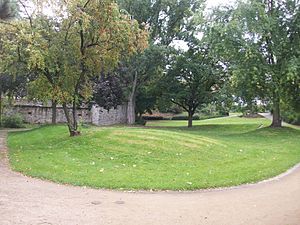Zwingenberg moated castle
| Zwingenberg moated castle | ||
|---|---|---|
|
Location of the former Katzenelnbogische moated castle on the southwest corner of the old city wall of Zwingenberg. View from the northwest. Visible remains of the wall |
||
| Alternative name (s): | Lower castle, lower castle, castle | |
| Creation time : | before 1250 | |
| Castle type : | Niederungsburg | |
| Conservation status: | Burgstall, small remains of the wall | |
| Standing position : | Counts, landgraves | |
| Place: | Zwingenberg | |
| Geographical location | 49 ° 43 '19.1 " N , 8 ° 36' 47.4" E | |
| Height: | 102 m above sea level NN | |
|
|
||
The moated castle Zwingenberg , also known as Unterburg or Untere Burg , is an abandoned moated castle , whose former location is today in a small park southwest of the market square on a corner of the old city wall of Zwingenberg in the Bergstrasse district in Hesse that can be seen from the B3 .
The remains of the foundations of the moated castle are among the oldest, if not the oldest, structures in the city of Zwingenberg and originally belonged to the former city fortifications .
Geographical location
The castle was located at the southwest end of the city wall of Zwingenberg and probably had a protective and control function for the trade routes that led past the Bergstrasse and was at the same time the residence castle of the Katzenelnbogen family in their upper county .
history
The castle, which was probably built by the Counts of Katzenelnbogen (Count Diether III. Von Katzenelnbogen (old line)), was expanded around 1250 and probably destroyed in 1301.
In the dispute over the customs system around 1301 between the Rhenish electors and King Albrecht I , the castle was probably destroyed by the king's troops because of the seizure of parties by the Counts of Katzenelnbogen in favor of the electors. According to the written documents, it is not possible to prove exactly whether the destroyed fortification is the older hilltop castle in the southeast of the city or the moated castle. According to Möller, the destruction of the moated castle can be assumed. If the older system still existed at that time, the destruction of both fortifications cannot be ruled out. As a result, Count Wilhelm von Katzenelnbogen led a feud against the Archbishopric of Mainz, since the Archbishop provided only limited funds for the reconstruction of the palace. In 1312, a settlement was finally arranged, as documented. Count Wilhelm von Katzenelnbogen left the allodial castle to the Archbishopric of Mainz . In return, Archbishop Gerhard II von Eppstein enfeoffed the Katzenelnbogen family with the castle and provided them with 200 marks of Cologne Heller, possibly as financing for reconstruction.
1402 or 1403 with the extinction of the Altkatzenelnbogischen line, the castle is inherited to the younger line. The moated castle was temporarily mortgaged in the 15th century. When the Katzenelnbogen family died out due to the death of Philip I von Katzenelnbogen , the inheritance went to Heinrich III. of Hesse , with the extinction of what was then Hesse-Marburg in 1500 to the Hesse-Kassel line in the form of Landgrave Wilhelm II of Hesse , who was thus able to rule over the entire Landgraviate of Hesse .
In September 1518, the Imperial Knight and Landsknechtsführer Franz von Sickingen had Zwingenberg occupied for a few days in the course of his feud against the Landgraviate of Hesse . After that the castle fell into disrepair.
After Hesse was quartered in 1567, Zwingenberg came to Landgrave Georg I of Hesse-Darmstadt .
On July 12, 1603, the castle was donated by Landgrave Ludwig V of Hessen-Darmstadt to the possession of the city of Zwingenberg. After that, the castle fell into disrepair and after 1850, in this year the last repairs were made according to the documentation of the winery expenses, the last remains were broken off. Today's Burgstall shows only small remains of the wall. The shape of the castle can still be guessed through the existing ramparts. It is not clear whether the windows and wall decorations to the south of the wall belonged to the castle.
literature
- Rudolf Knappe: Medieval castles in Hessen. 800 castles, castle ruins and fortifications. 2nd Edition. Wartberg-Verlag, Gudensberg-Gleichen 1995, ISBN 3-86134-228-6 .
- Georg Dehio : Handbook of German Art Monuments , Hesse II : Darmstadt District ", Cremer Folkhard (arr.), Deutscher Kunstverlag, 2008
- Rolf Müller (Ed.): Palaces, castles, old walls. Published by the Hessendienst der Staatskanzlei, Wiesbaden 1990, ISBN 3-89214-017-0 , p. 390.
- Walther Möller: History of the city of Zwingenberg on Bergstrasse: based on authentic sources , Zwingenberg, 1910, pp. 134–139
- Wolfgang Einsingbach: The art monuments of the state of Hesse. Bergstrasse district , 2 volumes, 1969, pp. 502–504
Web links
- Zwingenberg, Castle, Bergstrasse district. Historical local lexicon for Hesse (as of May 26, 2010). In: Landesgeschichtliches Informationssystem Hessen (LAGIS). Hessian State Office for Historical Cultural Studies (HLGL), accessed on November 28, 2012 .
Individual evidence
- ↑ not to be confused with the later hunting lodge of Landgrave Philip of Hesse
- ↑ Wasserburg Zwingenberg at belocal.de ( memento of the original from June 10, 2015 in the Internet Archive ) Info: The archive link has been inserted automatically and has not yet been checked. Please check the original and archive link according to the instructions and then remove this notice.
- ↑ Walther Möller: History of the city of Zwingenberg an der Bergstrasse: according to authentic sources , Zwingenberg, 1910
- ↑ Entry on Zwingenberg Castle in the private database "Alle Burgen".
- ↑ Walther Möller: History of the city of Zwingenberg an der Bergstrasse: based on authentic sources , Zwingenberg, 1910, p. 128






